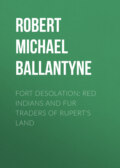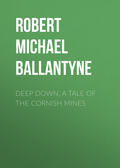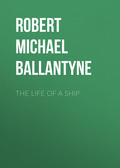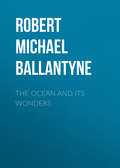
Robert Michael Ballantyne
Blown to Bits: The Lonely Man of Rakata, the Malay Archipelago
Chapter Twenty Nine
Tells Chiefly of the Wonderful Effects of this Eruption on the World at Large
The great explosions of that morning had done more damage and had achieved results more astounding than lies in the power of language adequately to describe, or of history to parallel.
Let us take a glance at this subject in passing.
An inhabitant of Anjer—owner of a hotel, a ship-chandler’s store, two houses, and a dozen boats—went down to the beach about six on the morning of that fateful 27th of August. He had naturally been impressed by the night of the 26th, though, accustomed as he was to volcanic eruptions, he felt no apprehensions as to the safety of the town. He went to look to the moorings of his boats, leaving his family of seven behind him. While engaged in this work he observed a wave of immense size approaching. He leaped into one of his boats, which was caught up by the wave and swept inland, carrying its owner there in safety. But this was the wave that sealed the doom of the town and most of its inhabitants, including the hotel-keeper’s family and all that he possessed.
This is one only out of thousands of cases of bereavement and destruction.
A lighthouse-keeper was seated in his solitary watch-tower, speculating, doubtless, on the probable continuance of such a violent outbreak, while his family and mates—accustomed to sleep in the midst of elemental war—were resting peacefully in the rooms below, when one of the mighty waves suddenly appeared, thundered past, and swept the lighthouse with all its inhabitants away.
This shows but one of the many disasters to lighthouses in Sunda Straits.
A Dutch man-of-war—the Berouw—was lying at anchor in Lampong Bay, fifty miles from Krakatoa. The great wave came, tore it from its anchorage, and carried it—like the vessel of our friend David Roy—nearly two miles inland! Masses of coral of immense size and weight were carried four miles inland by the same wave. The river at Anjer was choked up; the conduit which used to carry water into the place was destroyed, and the town itself was laid in ruins.
But these are only a few of the incidents of the great catastrophe. Who can conceive, much less tell of, those terrible details of sudden death and disaster to thousands of human beings, resulting from an eruption which destroyed towns like Telok Betong, Anjer, Tyringin, etcetera, besides numerous villages and hamlets on the shores of Java and Sumatra, and caused the destruction of more than 36,000 souls?
But it is to results of a very different kind, and on a much more extended scale, that we must turn if we would properly estimate the magnitude, the wide-spreading and far-reaching influences, and the extraordinary character, of the Krakatoa outburst of 1883.
In the first place, it is a fact, testified to by some of the best-known men of science, that the shock of the explosion extended appreciably right round the world, and seventeen miles, (some say even higher!) up into the heavens.
Mr Verbeek, in his treatise on this subject, estimates that a cubic mile of Krakatoa was propelled in the form of the finest dust into the higher regions of the atmosphere—probably about thirty miles! The dust thus sent into the sky was of “ultra-microscopic fineness,” and it travelled round and round the world in a westerly direction, producing those extraordinary sunsets and gorgeous effects and afterglows which became visible in the British Isles in the month of November following the eruption; and the mighty waves which caused such destruction in the vicinity of Sunda Straits travelled—not once, but at least—six times round the globe, as was proved by trustworthy and independent observations of tide-gauges and barometers made and recorded at the same time in nearly all lands—including our own.
Other volcanoes, it is said by those who have a right to speak in regard to such matters, have ejected more “stuff,” but not one has equalled Krakatoa in the intensity of its explosions, the appalling results of the sea-waves, the wonderful effects in the sky, and the almost miraculous nature of the sounds.
Seated on a log under a palm-tree in Batavia, on that momentous morning of the 27th, was a sailor who had been left behind sick by Captain Roy when he went on his rather Quixotic trip to the Keeling Islands. He was a somewhat delicate son of the sea. Want of self-restraint was his complaint—leading to a surfeit of fruit and other things, which terminated in a severe fit of indigestion and indisposition to life in general. He was smoking—that being a sovereign and infallible cure for indigestion and all other ills that flesh is heir to, as every one knows!
“I say, old man,” he inquired, with that cheerful tone and air which usually accompanies incapacity for food. “Do it always rain ashes here?”
The old man whom he addressed was a veteran Malay seaman.
“No,” replied the Malay, “sometimes it rain mud—hot mud.”
“Do it? Oh! well—anything for variety, I s’pose,” returned the sailor, with a growl which had reference to internal disarrangements.
“Is it often as dark as this in the daytime, an’ is the sun usually green?” he asked carelessly, more for the sake of distracting the mind from other matters than for the desire of knowledge.
“Sometime it’s more darker,” replied the old man. “I’ve seed it so dark that you couldn’t see how awful dark it was.”
As he spoke, a sound that has been described by ear-witnesses as “deafening,” smote upon their tympanums, the log on which they sat quivered, the earth seemed to tremble, and several dishes in a neighbouring hut were thrown down and broken.
“I say, old man, suthin’ busted there,” remarked the sailor, taking the pipe from his mouth and quietly ramming its contents down with the end of his blunt forefinger.
The Malay looked grave.
“The gasometer?” suggested the sailor.
“No, that never busts.”
“A noo mountain come into action, p’raps, an blow’d its top off?”
“Shouldn’t wonder if that’s it—close at hand too. We’s used to that here. But them’s bigger cracks than or’nar’.”
The old Malay was right as to the cause, but wrong as to distance. Instead of being a volcano “close at hand,” it was Krakatoa eviscerating itself a hundred miles off, and the sound of its last grand effort “extended over 50 degrees, equal to about 3000 miles.”
On that day all the gas lights were extinguished in Batavia, and the pictures rattled on the walls as though from the action of an earthquake. But there was no earthquake. It was the air-wave from Krakatoa, and the noise produced by the air-waves that followed was described as “deafening.”
The effect of the sounds of the explosions on the Straits Settlements generally was not only striking but to some extent amusing. At Carimon, in Java—355 miles distant from Krakatoa—it was supposed that a vessel in distress was firing guns, and several native boats were sent off to render assistance, but no distressed vessel was to be found! At Acheen, in Sumatra—1073 miles distant—they supposed that a fort was being attacked and the troops were turned out under arms. At Singapore—522 miles off—they fancied that the detonations came from a vessel in distress and two steamers were despatched to search for it. And here the effect on the telephone, extending to Ishore, was remarkable. On raising the tubes a perfect roar as of a waterfall was heard. By shouting at the top of his voice, the clerk at one end could make the clerk at the other end hear, but he could not render a word intelligible. At Perak—770 miles off—the sounds were thought to be distant salvos of artillery, and Commander the Honourable F Vereker, R.N., of H.M.S. Magpie, when 1227 miles distant, (in latitude 5 degrees 52 minutes North, longitude 118 degrees 22 minutes East), states that the detonations of Krakatoa were distinctly heard by those on board his ship, and by the inhabitants of the coast as far as Banguey Island, on August 27th. He adds that they resembled distant heavy cannonading. In a letter from Saint Lucia Bay—1116 miles distant—it was stated that the eruption was plainly heard all over Borneo. A government steamer was sent out from the Island of Timor—1351 miles off—to ascertain the cause of the disturbance! In South Australia also, at places 2250 miles away, explosions were heard on the 26th and 27th which “awakened” people, and were thought worthy of being recorded and reported. From Tavoy, in Burmah—1478 miles away—the report came— “All day on August 27th unusual sounds were heard, resembling the boom of guns. Thinking there might be a wreck or a ship in distress, the Tavoy Superintendent sent out the police launch, but they ‘could see nothing.’” And so on, far and near, similar records were made, the most distant spot where the sounds were reported to have been heard being Rodriguez, in the Pacific, nearly 3000 miles distant!
One peculiar feature of the records is that some ships in the immediate neighbourhood of Krakatoa did not experience the shock in proportionate severity. Probably this was owing to their being so near that a great part of the concussion and sound flew over them—somewhat in the same way that the pieces of a bomb-shell fly over men who, being too near to escape by running, escape by flinging themselves flat on the ground.
Each air-wave which conveyed these sounds, commencing at Krakatoa as a centre, spread out in an ever-increasing circle till it reached a distance of 180 degrees from its origin and encircled the earth at its widest part, after which it continued to advance in a contracting form until it reached the antipodes of the volcano; whence it was reflected or reproduced and travelled back again to Krakatoa. Here it was turned right-about-face and again despatched on its long journey. In this way it oscillated backward and forward not fewer than six times before traces of it were lost. We say “traces,” because these remarkable facts were ascertained, tracked, and corroborated by independent barometric observation in all parts of the earth.
For instance, the passage of the great air-wave from Krakatoa to its antipodes, and from its antipodes back to Krakatoa, was registered six times by the automatic barometer at Greenwich. The instrument at Kew Observatory confirmed the records of Greenwich, and so did the barometers of other places in the kingdom. Everywhere in Europe also this fact was corroborated, and in some places even a seventh oscillation was recorded. The Greenwich record shows that the air-waves took about thirty-six hours to travel from pole to pole, thus proving that they travelled at about the rate of ordinary sound-waves, which, roughly speaking, travel at the rate of between six and seven hundred miles an hour.
The height of the sea-waves that devastated the neighbouring shores, being variously estimated at from 50 to 135 feet, is sufficiently accounted for by the intervention of islands and headlands, etcetera, which, of course, tended to diminish the force, height, and volume of waves in varying degrees.
These, like the air-waves, were also registered—by self-acting tide-gauges and by personal observation—all over the world, and the observations coincided as to date with the great eruptions of the 26th and 27th of August. The influence of the sea-waves was observed and noted in the Java sea—which is shallow and where there are innumerable obstructions—as far as 450 miles, but to the west they swept over the deep waters of the Indian Ocean on to Cape Horn, and even, it is said, to the English Channel.
The unusual disturbance of ocean in various places was sufficiently striking. At Galle, in Ceylon, where the usual rise and fall of the tide is 2 feet, the master-attendant reports that on the afternoon of the 27th four remarkable waves were noticed in the port. The last of these was preceded by an unusual recession of the sea to such an extent that small boats at their anchorage were left aground—a thing that had never been seen before. The period of recession was only one-and-a-half minutes; then the water paused, as it were, for a brief space, and, beginning to rise, reached the level of the highest high-water mark in less than two minutes, thus marking a difference of 8 feet 10 inches instead of the ordinary 2 feet.
At one place there was an ebb and flood tide, of unusual extent, within half-an-hour. At another, a belt of land, including a burying-ground, was washed away, so that, according to the observer, “it appeared as if the dead had sought shelter with the living in a neighbouring cocoa-nut garden!” Elsewhere the tides were seen to advance and recede ten or twelve times—in one case even twenty times—on the 27th. At Trincomalee the sea receded three times and returned with singular force, at one period leaving part of the shore suddenly bare, with fish struggling in the mud. The utilitarian tendency of mankind was at once made manifest by some fishermen who, seizing the opportunity, dashed into the struggling mass and began to reap the accidental harvest, when—alas for the poor fishermen!—the sea rushed in again and drove them all away.
In the Mauritius, however, the fishers were more fortunate, for when their beach was exposed in a similar manner, they succeeded in capturing a good many fish before the water returned.
Even sharks were disturbed in their sinister and slimy habits of life by this outburst of Krakatoa—and no wonder, when it is recorded that in some places “the sea looked like water boiling heavily in a pot,” and that “the boats which were afloat were swinging in all directions.” At one place several of these monsters were flung out of their native home into pools, where they were left struggling till their enemy man terminated their career.
Everywhere those great waves produced phenomena which were so striking as to attract the attention of all classes of people, to ensure record in most parts of the world, and to call for the earnest investigation of the scientific men of many lands—and the conclusion to which such men have almost universally come is, that the strange vagaries of the sea all over the earth, the mysterious sounds heard in so many widely distant places, and the wonderful effects in the skies of every quarter of the globe, were all due to the eruption of the Krakatoa volcano in 1883.
With reference to these last—the sky-effects—a few words may not be out of place here.
The superfine “ultra-microscopic” dust, which was blown by the volcano in quantities so enormous to such unusual heights, was, after dropping its heavier particles back to earth, caught by the breezes which always blow in the higher regions from east to west, and carried by them for many months round and round the world. The dust was thickly and not widely spread at first, but as time went on it gradually extended itself on either side, becoming visible to more and more of earth’s inhabitants, and at the same time becoming necessarily less dense.
Through this medium the sun’s rays had to penetrate. In so far as the dust-particles were opaque they would obscure these rays; where they were transparent or polished they would refract and reflect them. That the material of which those dust-particles was composed was very various has been ascertained, proved, and recorded by the Krakatoa Committee. The attempt to expound this matter would probably overtax the endurance of the average reader, yet it may interest all to know that this dust-cloud travelled westward within the tropics at the rate of about double the speed of an express train—say 120 miles an hour; crossed the Indian Ocean and Africa in three days, the Atlantic in two, America in two, and, in short, put a girdle round the world in thirteen days. Moreover, the cloud of dust was so big that it took two or three days to pass any given point. During its second circumnavigation it was considerably spread and thinned, and the third time still more so, having expanded enough to include Europe and the greater part of North America. It had thinned away altogether and disappeared in the spring of 1884.
Who has not seen—at least read or heard of—the gorgeous skies of the autumn of 1883? Not only in Britain, but in all parts of the world, these same skies were seen, admired, and commented on as marvellous. And so they were. One of the chief peculiarities about them, besides their splendour, was the fact that they consisted chiefly of “afterglows”—that is, an increase of light and splendour after the setting of the sun, when, in an ordinary state of things, the grey shadows of evening would have descended on the world. Greenish-blue suns; pink clouds; bright yellow, orange, and crimson afterglows; gorgeous, magnificent, blood-red skies—the commentators seemed unable to find language adequately to describe them. Listen to a German observer’s remarks on the subject:—
“The display of November 29th was the grandest and most manifold. I give a description as exactly as possible, for its overwhelming magnificence still presents itself to me as if it had been yesterday. When the sun had set about a quarter of an hour there was not much afterglow, but I had observed a remarkably yellow bow in the south, about 10 degrees above the horizon. In about ten minutes more this arc rose pretty quickly, extended itself all over the east and up to and beyond the zenith. The sailors declared, ‘Sir, that is the Northern Lights.’ I thought I had never seen Northern Lights in greater splendour. After five minutes more the light had faded, though not vanished, in the east and south, and the finest purple-red rose up in the south-west; one could imagine one’s-self in Fairyland.”
All this, and a great deal more, was caused by the dust of Krakatoa!
“But how—how—why?” exclaims an impatient and puzzled reader.
“Ay—there’s the rub.” Rubbing, by the way, may have had something to do with it. At all events we are safe to say that whatever there was of electricity in the matter resulted from friction.
Here is what the men of science say—as far as we can gather and condense.
The fine dust blown out of Krakatoa was found, under the microscope, to consist of excessively thin, transparent plates or irregular specks of pumice—which inconceivably minute fragments were caused by enormous steam pressure in the interior and the sudden expansion of the masses blown out into the atmosphere. Of this glassy dust, that which was blown into the regions beyond the clouds must have been much finer even than that which was examined. These glass fragments were said by Dr Flügel to contain either innumerable air-bubbles or minute needle-like crystals, or both. Small though these vesicles were when ejected from the volcano, they would become still smaller by bursting when they suddenly reached a much lower pressure of atmosphere at a great height. Some of them, however, owing to tenacity of material and other causes, might have failed to burst and would remain floating in the upper air as perfect microscopic glass balloons. Thus the dust was a mass of particles of every conceivable shape, and so fine that no watches, boxes, or instruments were tight enough to exclude from their interior even that portion of the dust which was heavy enough to remain on earth!
Now, to the unscientific reader it is useless to say more than that the innumerable and varied positions of these glassy particles, some transparent, others semi-transparent or opaque, reflecting the sun’s rays in different directions, with a complex modification of colour and effect resulting from the blueness of the sky, the condition of the atmosphere, and many other causes—all combined to produce the remarkable appearances of light and colour which aroused the admiration and wonder of the world in 1883.
The more one thinks of these things, and the deeper one dives into the mysteries of nature, the more profoundly is one impressed at once with a humbling sense of the limited amount of one’s knowledge, and an awe-inspiring appreciation of the illimitable fields suggested by that comprehensive expression: “The Wonderful Works of God.”







